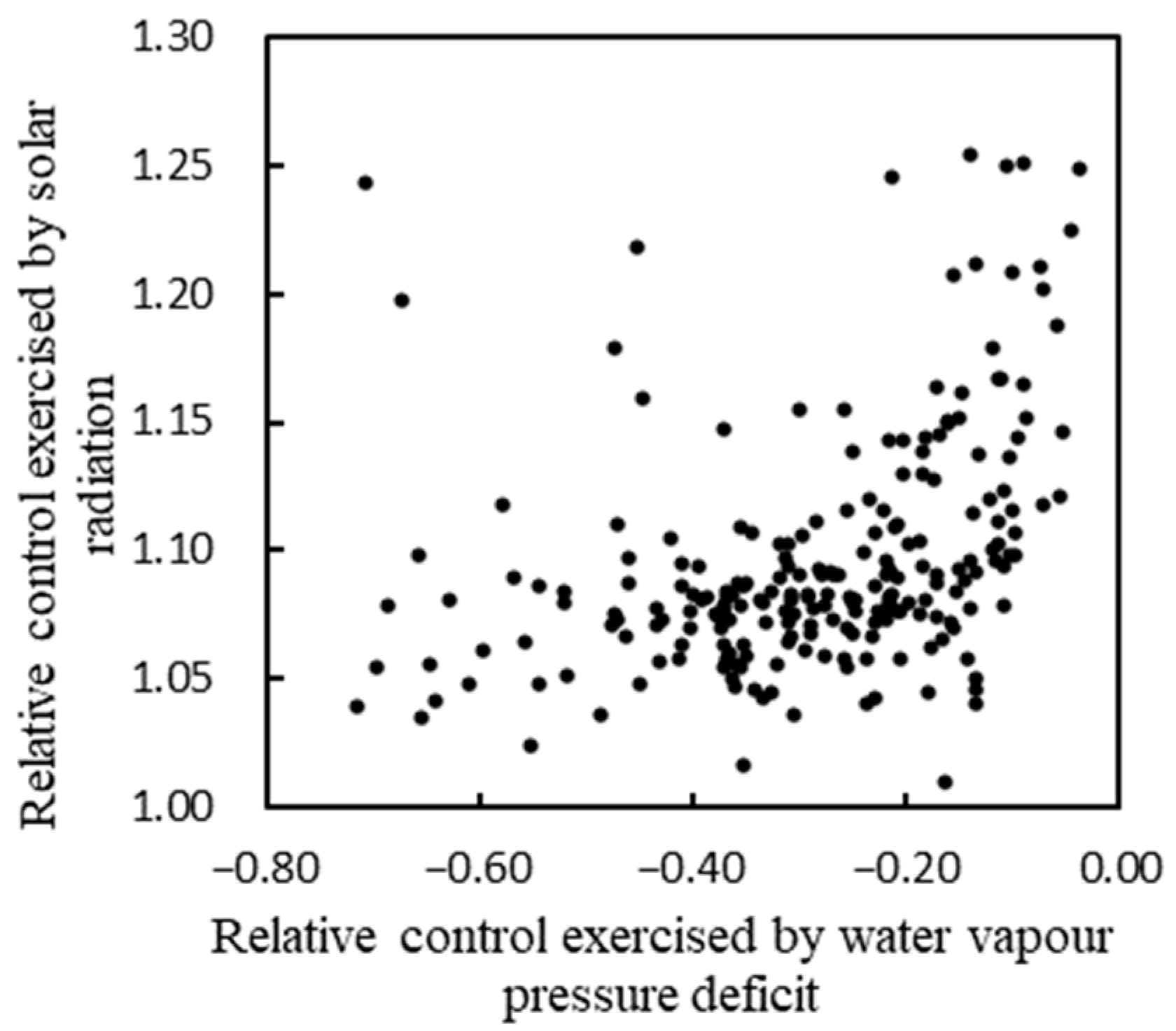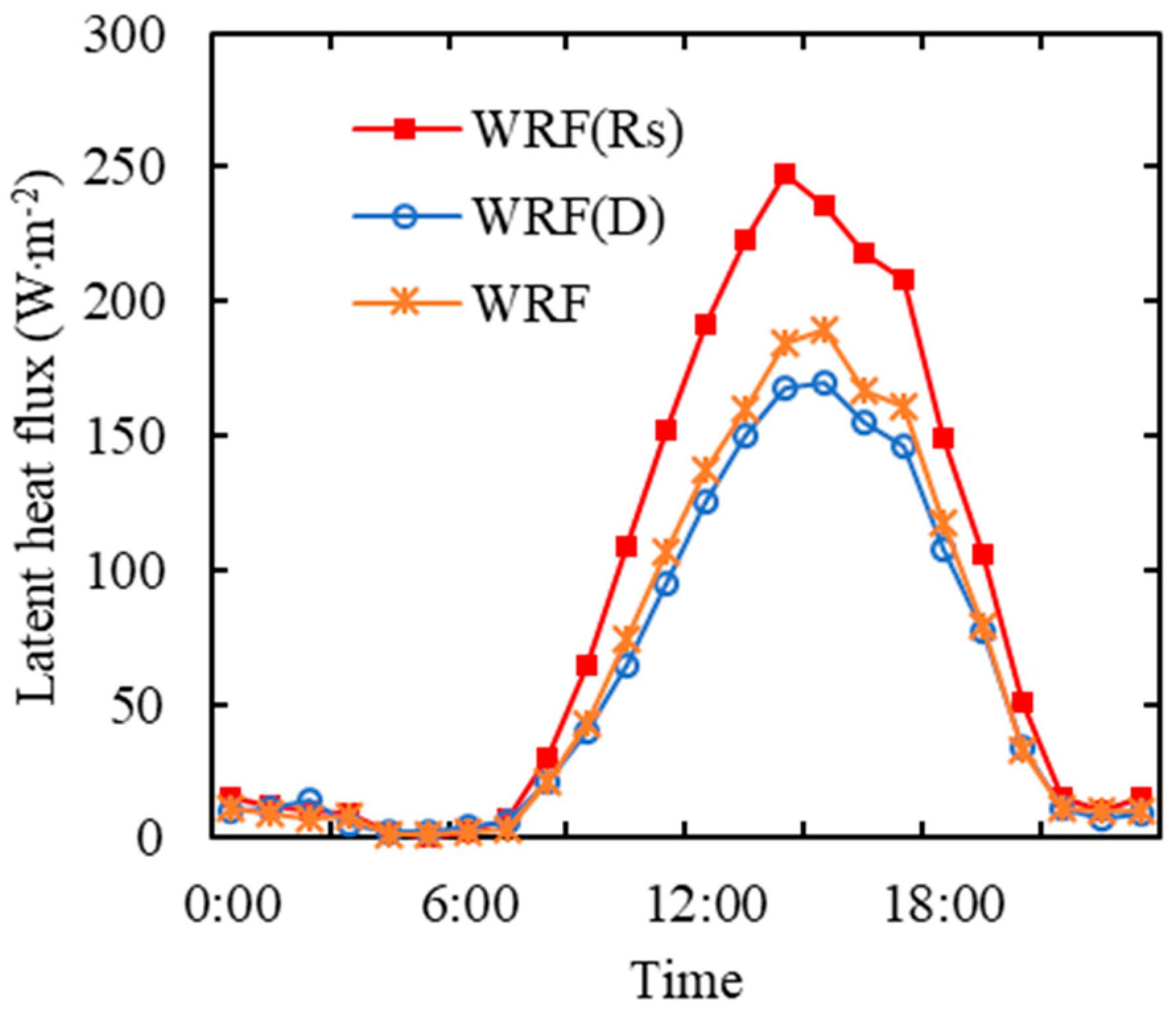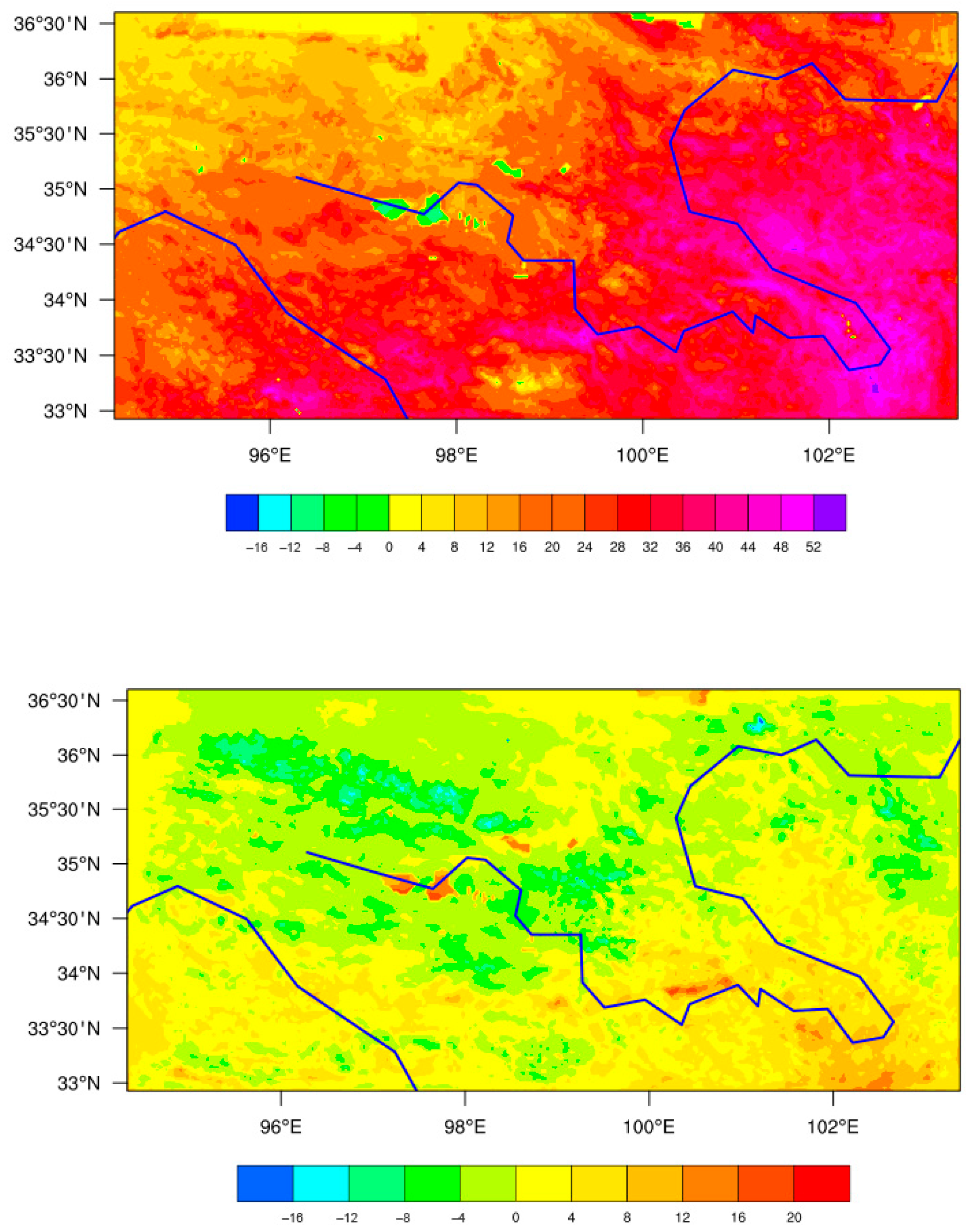A Study of the Influence of Environmental Factors on Water–Heat Exchange Process in Alpine Wetlands
Abstract
:1. Introduction
2. Materials
2.1. Site Description
2.2. Datasets
- (1)
- Due to precipitation, the latent heat flux at noon is negative, and the radiation data are not stable; thus, only data from clear days are used.
- (2)
- When turbulence is weak, the uncertainty of the flux data is large. The friction wind speed (u*) is the measure of the turbulence intensity. All flux data where u* > 0.1 m·s−1 are selected.
- (3)
- As turbulence is weak at night, the sensor probe is easily covered by dew condensation or frost, and the night-time latent heat flux is small. Therefore, the data can only be used when the downward shortwave radiation is greater than zero.
3. Methods
3.1. Calculation of Control
3.2. Coupling between Alpine Wetlands and Atmosphere
4. Model Scheme Design
4.1. Introduction of WRF Model
4.2. Modification of the Noah LSM
4.3. Simulation Scheme
5. Results and Discussion
5.1. Relative Control Exercised by Environmental Factors over Latent Heat Flux
5.2. Adaptability of Model in Alpine Wetlands Surface
5.3. WRF+ Simulating the Influence of Environmental Factors on Latent Heat Flux
6. Summary and Conclusions
- (1)
- The relative control exercised by solar radiation over latent heat flux gradually decreases with the increase in the solar radiation, and the absolute value of the relative control exercised by water vapor pressure deficit over latent heat flux increases with the increase in vapor pressure deficit. The water vapor pressure deficit always plays a role in reducing the surface latent heat flux in the alpine wetlands over the Yellow River source region; however, solar radiation plays the opposite role. In addition, the opposite effect of solar radiation and water vapor pressure deficit on the latent heat flux is not corresponding. The relative control exercised by solar radiation and water vapor pressure deficit over latent heat flux are calculated to be 1.10 and −0.29, and solar radiation is the main factor affecting the latent heat flux in alpine wetlands.
- (2)
- During the vegetation growing season, the average value of Ω is 0.38 in alpine wetlands. The relatively large value indicates that the coupling between the wetland and the atmosphere is poor in this period, and the latent heat flux is mainly affected by solar radiation. The actual situation is consistent with this. The latent heat flux is mainly affected by solar radiation in alpine wetlands surface with sufficient water supply and low aerodynamic resistance.
- (3)
- Referring to the results of previous scholars’ improvement of the parameterization scheme for land–surface processes in alpine wetlands and applying them to land–atmosphere coupling, which enables WRF+ to increase the amplitude of oscillations in the latent heat fluxes and narrow the root–mean–square deviation of turbulent fluxes, effectively. In aggregate, WRF+ can better simulate the spatiotemporal variation characteristics of energy flux in alpine wetlands over the source region of the Yellow River. Therefore, it is feasible to use WRF+ to simulate the latent heat flux with changing environmental factors.
- (4)
- Using WRF+ to simulate the latent heat fluxes under changing environmental factors, it was found that for the underlying surfaces of alpine wetlands, solar radiation is still the main environmental factor affecting latent heat flux, and the influence degree is five times that of water vapor pressure deficit. When solar radiation increases by 30%, the diurnal peak value of latent heat flux increases from 189.64 W·m−2 to 247.60 W·m−2, and the average daily amount of latent heat flux increases from 5.57 MJ·m−2 to 7.50 MJ·m−2. When water vapor pressure deficit increases by 30%, the diurnal peak value of latent heat flux decreases to 169.19 W·m−2, and the average daily amount of latent heat flux decreases to 5.17 MJ·m−2.
Author Contributions
Funding
Institutional Review Board Statement
Informed Consent Statement
Data Availability Statement
Conflicts of Interest
References
- Hu, Y.Q. Research advance about the energy budget and transportation of water vapour in the HEIFE area. Adv. Earth Sci. 1994, 9, 30–34. [Google Scholar]
- Li, Y.N.; Shi, S.B.; Cao, G.M.; Yang, Y.G.; Shen, Z.X. The observational studies on characteristics of microclimate in Haibei alpine meadow regions of Qi-Lian mountain. Plateau Meteorol. 2000, 19, 512–519. [Google Scholar]
- Zhang, Q.; Cao, X.Y. The influence of synoptic conditions on the averaged surface heat and radiation budget energy over desert or gobi. Chin. J. Atmos. Sci. 2003, 27, 245–254. [Google Scholar]
- Bao, Y.; Zuo, H.C.; Lv, S.H. The effect of improved land surface process parameters in arid area on climatic simulation in GCM. Plateau Meteorol. 2004, 23, 220–227. [Google Scholar]
- Ling, Z.; Shi, Z.T.; Gu, S.X.; Peng, H.Y.; Feng, G.J.; Huo, H. Energy balance and evapotranspiration characteristics of rubber tree (Hevea brasiliensis) plantations in Xishuangbanna, Southwest of China. Appl. Ecol. Environ. Res. 2022, 20, 103–117. [Google Scholar] [CrossRef]
- Trenberth, K.E.; Caron, J.M.; Stepaniak, D.P. The atmospheric energy budget and implications for surface fluxes and ocean heat transports. Clim. Dyn. 2001, 17, 259–276. [Google Scholar] [CrossRef]
- Mahrt, L.; Vickers, D. Boundary-Layer adjustment over small scale changes of surface heat flux. Bound.-Layer Meteorol. 2005, 116, 313–330. [Google Scholar] [CrossRef]
- Zhu, C.M.; Lettenmaier, D.P. Long-term climate and derived surface hydrology and energy flux data for Mexico: 1925–2004. J. Clim. 2007, 20, 1936–1946. [Google Scholar] [CrossRef]
- Jacobs, C.M.J.; De Bruin, H.A.R. The Sensitivity of Regional Transpiration to Land Surface Characteristics: Significance of Feedback. J. Clim. 1992, 5, 683–698. [Google Scholar] [CrossRef]
- Sun, J.Q.; Li, H.Y.; Wang, X.J.; Shamsuddin, S. Water resources response and prediction under climate change in Tao’er River Basin, Northeast China. J. Mt. Sci. 2021, 18, 2635–2645. [Google Scholar] [CrossRef]
- Penman, H.L.; Schofield, R.K. Some physical aspects of assimilation and transpiration: Carbon dioxide fixation and photosynthesis. Symposia. Soc. Exptl. Biol. 1951, 5, 115–129. [Google Scholar]
- Bange, G.G.J. On the quantitative explanation of stomatal transpiration. Acta Bot. Neerl. 1953, 2, 255–297. [Google Scholar] [CrossRef]
- McNaughton, K.G.; Jarvis, P.G. Predicting effects of vegetation changes on transpiration and evaporation. In Water Deficits and Plant Growth, 1st ed.; Kozlowski, T.T., Ed.; Academic Press: Cambridge, MA, USA, 1983; Volume 7, pp. 1–47. [Google Scholar]
- Jarvis, P.G.; McNaughton, K.G. Stomatal Control of Transpiration: Scaling Up from Leaf to Region. Adv. Ecol. Res. 1986, 15, 1–49. [Google Scholar]
- Kellner, E. Surface Energy Fluxes and Control of Evapotranspiration from a Swedish Sphagnum Mire. Agric. For. Meteorol. 2001, 110, 101–123. [Google Scholar] [CrossRef]
- Wever, L.A.; Flanagan, L.B.; Carlson, P.J. Seasonal and interannual variation in evapotranspiration, energy balance and surface conductance in a northern temperate grassland. Agric. For. Meteorol. 2002, 112, 31–49. [Google Scholar] [CrossRef]
- Al-Shibli, F.M.; Ottom, M.A.; Saoub, H.; Al-weshah, R. Comparative analysis of potential evapotranspiration calculation methods with ERA-reanalysis climate models’ projections in Western Asia, Jordan. Appl. Ecol. Environ. Res. 2021, 19, 4849–4879. [Google Scholar] [CrossRef]
- Li, F.X.; Chang, G.G.; Xiao, J.S.; Zhou, B.R.; Fu, Y. Relationship between wetlands changes and climate change in the Yellow River source region. J. Nat. Resour. 2009, 24, 683–690. [Google Scholar]
- Li, Z.G.; Lu, S.H.; Ao, Y.H.; Wen, X. Numerical Simulation of Impact of Ecological Environment Change on Lake Effect in the Source Region of the Yellow River. Plateau Meteorol. 2012, 31, 1591–1600. [Google Scholar]
- Tan, P. Discuss the importance of wetland protection and reverting cultivated land to wetland. Resour. Econ. Environ. Prot. 2014, 3, 142–143. [Google Scholar]
- Lin, Z.Y.; Xiao, Y.; Ouyang, Z.Y. Assessment of ecological importance of the Qinghai-Tibet Plateau based on ecosystem service flows. J. Mt. Sci. 2021, 18, 1725–1736. [Google Scholar] [CrossRef]
- Wang, Q.G.; Kellomäki, S. Role of solar radiation and water vapour pressure deficit in controlling latent heat flux density in a cots pine forest. Bound.-Layer Meteorol. 2005, 115, 131–149. [Google Scholar] [CrossRef]
- Yu, W.Y.; Zhou, G.S.; Chi, D.C.; He, Q.J.; Zhou, L. Evapotranspiration of phragmites communis community in Panjin wetland and its controlling factors. Acta Ecol. Sin. 2008, 28, 4594–4601. [Google Scholar]
- Wang, X.X.; Liu, X.; Chen, S.H.; Zhu, Q.J.; Hu, Y.M. Correlation analysis of water and heat fluxes with environmental variables over lawn in semi-arid area. J. Basic Sci. Eng. 2008, 16, 770–777. [Google Scholar]
- Ding, R.S.; Kang, S.Z.; Zhang, Y.Q.; Tong, L.; Li, S.E. Characteristics of water vapor and heat fluxes and the controlling factors over a maize field in the arid inland region. J. Hydraul. Eng. 2014, 45, 312–319. [Google Scholar]
- Li, Y.J. Environmental controls on water and heat exchanges over rainfed maize cropland in northeast China. Clim. Environ. Res. 2015, 20, 71–79. [Google Scholar]
- Wu, X.M.; Ma, W.Q.; Ma, Y.M. Observation and simulation analyses on characteristics of land surface heat flux in northern Qinghai-Xizang Plateau in summer. Plateau Meteorol. 2013, 32, 1246–1252. [Google Scholar]
- Ye, J.; Peng, L.C.; Liao, Q.; Li, Z.M. Estimation of latent heat flux over semiarid areas for clear sky days using modis data. Acta Sci. Nat. Univ. Pekin. 2014, 50, 835–842. [Google Scholar]
- Vladimirov, E.; Dimitrova, R.; Danchovski, V. Sensitivity of wrf model results to topography and land cover: Study for the sofia region. Annu. Sofia 2018, 111, 87–101. [Google Scholar]
- Chen, F.; Janjić, Z.; Mitchell, K. Impact of atmospheric surface-layer parameterizations in the new land-surface scheme of the NCEP Mesoscale Eta Model. Bound.-Layer Meteorol. 1997, 85, 391–421. [Google Scholar] [CrossRef]
- Pielke, R.A.; Lee, T.J.; Copeland, J.H.; Eastman, J.L.; Ziegler, C.L.; Finley, C.A. Use of USGS-provided data to improve weather and climate simulations. Ecol. Appl. 1997, 7, 3–21. [Google Scholar]
- Chen, F.; Dudhia, J. Coupling an advanced land surface-hydrology model with the Penn State-NCAR MM5 modeling system. Part II: Preliminary model validation. Mon. Weather Rev. 2001, 129, 587–604. [Google Scholar] [CrossRef]
- Zeng, X.B.; Shaikh, M.; Dai, Y.; Dickinson, R.E.; Myneni, R. Coupling of the common land model to the NCAR community climate model. J. Clim. 2002, 15, 1832–1854. [Google Scholar] [CrossRef]
- Chen, J.L.; Wen, J.; Tian, H. Up-Scaling Research for Soil Moisture in Yellow River Source Region. Plateau Meteorol. 2016, 35, 1212–1213. [Google Scholar]
- Li, L.G.; Luo, S.D.W. Dictionary of Political Regions of the People’s Republic of China: Qinghai Province, 1st ed.; China Society Press: Beijing, China, 2016; p. 460. [Google Scholar]
- Guo, J.X.; Mei, X.R.; Lu, Z.G.; Zhao, Q.S. Field evapotranspiration measurement based on eddy covariance technology. Sci. Agric. Sin. 2004, 8, 1172–1176. [Google Scholar]
- Li, Y.J.; Xu, Z.Z.; Wang, Y.L.; Zhou, L.; Zhou, G.S. Latent and sensible heat fluxes and energy balance in a maize agroecosystem. Chin. J. Plant Ecol. 2007, 31, 1132–1144. [Google Scholar]
- He, J.J. Characteristic of latent heat flux in typical steppe. Chin. Agric. Sci. Bull. 2014, 30, 195–199. [Google Scholar]
- Monteith, J.L. Principles of Environmental Physics, 3rd ed.; Elsevier: Amsterdam, The Netherlands; Boston, MA, USA, 2008; pp. 1–366. [Google Scholar]
- Stewart, J.B. Modelling Surface Conductance of Pine Forest. Agric. For. Meteorol. 1988, 43, 19–35. [Google Scholar] [CrossRef]
- Cienciala, E.; Kučera, J.; Lindroth, A.; Čermák, J. Canopy transpiration from a boreal forest in Sweden during a dry year. Agric. For. Meteorol. 1997, 86, 157–167. [Google Scholar] [CrossRef]
- Steduto, P.; Hsiao, T.C. Maize canopies under two soil water regimes: Ⅲ. Variation in coupling with the atmosphere and the role of leaf area index. Agric. For. Meteorol. 1998, 89, 201–213. [Google Scholar] [CrossRef]
- Li, H.M.; Li, L.; Zhang, J.X.; Shi, X.H.; Shen, H.Y.; Wang, Z.Y. Change in extreme climatic events over the sources of the three rivers in the prometaphase 21st century. J. Glaciol. Geocryol. 2012, 34, 1403–1408. [Google Scholar]
- Wang, C.H.; Sun, C. Design and preliminary test of the regional climate model (WRFC) based on coupling WRF3.2 and CLM4.0. Plateau Meteorol. 2013, 32, 1626–1637. [Google Scholar]
- Xin, Y.; Wang, C.H.; Shen, Y.F.; Chen, H.W. Forecast examination of surface global horizontal irradiance over middle of xinjiang using WRF model. Plateau Meteorol. 2013, 32, 1368–1381. [Google Scholar]
- Wang, T.J.; Zhang, L.; Hu, X.J.; Zhao, S.Q.; Wang, J. Numerical simulation of summer boundary layer structure over undulating topography of loess plateau simulated by WRF model. Plateau Meteorol. 2013, 32, 1261–1271. [Google Scholar]
- Wen, X.H.; Dong, W.J.; Liao, X.H. Numerical simulations of radiation budget and energy balance using WRF model in summer over semi-arid northeastern China. Acta Energiae Solaris Sin. 2015, 36, 2196–2203. [Google Scholar]
- EK, M.B.; Mitchell, K.E.; Lin, Y.; Rogers, E.; Grunmann, P.; Koren, V.; Gayno, G.; Tarpley, J.D. Implementation of Noah land surface model advances in the National Centers for Environmental Prediction operational mesoscale Eta Model. J. Geophys. Res. Atmos. 2003, 108, 8851. [Google Scholar] [CrossRef]
- Mahrt, L.; Ek, M. The influence of atmosphere stability on potential evaporation. J. Appl. Meteorol. Climatol. 1984, 23, 222–234. [Google Scholar] [CrossRef]
- Mahrt, L.; Pan, H. A two-layer model of soil hydrology. Bound.-Layer Meteorol. 1984, 29, 1–20. [Google Scholar] [CrossRef]
- Pan, H.L.; Mahrt, L. Interaction between soil hydrology and boundary-layer development. Bound. -Layer Meteorol. 1987, 38, 185–202. [Google Scholar] [CrossRef]
- Chen, J.L.; Wen, J.; Wang, X.; Zhang, T.T.; Jia, D.Y.; Zhou, J.; Wang, Z.L. Characteristics of water and heat exchanges and their crucial influencing factors on the alpine wetland during the warm season in the source region of the Yellow River. Chin. J. Atmos. Sci. 2017, 41, 302–312. (In Chinese) [Google Scholar]
- Chen, J.L.; Wen, J.; Tian, H.; Zhang, T.T.; Yang, X.Y.; Jia, D.Y.; Lai, X. A Study of Soil Thermal and Hydraulic Properties and Parameterizations for CLM in the SRYR. J. Geophys. Res. Atmos. 2018, 123, 8487–8499. [Google Scholar] [CrossRef]
- Cosby, B.J.; Hornberger, G.M.; Clapp, R.B.; Ginn, T.R. A statistical exploration of the relationships of soil moisture characteristics to the physical properties of soils. Water Resour. Res. 1984, 20, 682–690. [Google Scholar] [CrossRef]
- Xu, X.Z.; Wang, J.C.; Zhang, L.X. Physics of Frozen Soil, 2nd ed.; Science Press: Beijing, China, 2010; pp. 1–367. [Google Scholar]
- Jarvis, P.G.; Massheder, J.M.; Hale, S.E.; Moncrieff, J.B.; Rayment, M.; Scott, S.L. Seasonal variation of carbon dioxide, water vapor and energy exchanges of a boreal black spruce forest. J. Geophys. Res. Atmos. 1997, 102, 28953–28966. [Google Scholar] [CrossRef]
- Baldocchi, D.; Kelliher, F.M.; Black, T.A.; Jarvis, P. Climate and vegetation controls on boreal zone energy exchange. Glob. Change Biol. 2000, 6, 69–83. [Google Scholar] [CrossRef] [PubMed]








| Domain | Center Coordinates/(°E, °N) | Grid Points | Horizontal Spacing/Km | Time Step/s |
|---|---|---|---|---|
| 1 | 35.0, 99.0 | 41 × 25 | 27 | 162 |
| 2 | 35.0, 99.0 | 280 × 136 | 3 | 18 |
| Physical Parameterization Scheme | WRF | WRF+ |
|---|---|---|
| Longwave Radiation | RRTM | RRTM |
| Shortwave Radiation | MM5 | MM5 |
| Microphysics | WSM3 | WSM3 |
| Surface Laye | MM5 | MM5 |
| Planetary Boundary Layer | YSU | YSU |
| Land Surface | Noah | Modified Noah |
| WRF | WRF+ | |||||
|---|---|---|---|---|---|---|
| R2 | RMSD (W·m−2) | MAE (W·m−2) | R2 | RMSD (W·m−2) | MAE (W·m−2) | |
| Latent heat flux | 0.69 | 58.06 | 35.58 | 0.75 | 49.94 | 30.65 |
| Sensible heat flux | 0.80 | 79.41 | 50.12 | 0.81 | 62.20 | 39.27 |
| Net radiation | 0.88 | 122.10 | 78.18 | 0.89 | 115.84 | 74.07 |
Disclaimer/Publisher’s Note: The statements, opinions and data contained in all publications are solely those of the individual author(s) and contributor(s) and not of MDPI and/or the editor(s). MDPI and/or the editor(s) disclaim responsibility for any injury to people or property resulting from any ideas, methods, instructions or products referred to in the content. |
© 2023 by the authors. Licensee MDPI, Basel, Switzerland. This article is an open access article distributed under the terms and conditions of the Creative Commons Attribution (CC BY) license (https://creativecommons.org/licenses/by/4.0/).
Share and Cite
Xie, Y.; Wen, J.; Zhang, Y.; Chen, J.; Yang, X. A Study of the Influence of Environmental Factors on Water–Heat Exchange Process in Alpine Wetlands. Atmosphere 2023, 14, 1802. https://doi.org/10.3390/atmos14121802
Xie Y, Wen J, Zhang Y, Chen J, Yang X. A Study of the Influence of Environmental Factors on Water–Heat Exchange Process in Alpine Wetlands. Atmosphere. 2023; 14(12):1802. https://doi.org/10.3390/atmos14121802
Chicago/Turabian StyleXie, Yan, Jun Wen, Yulin Zhang, Jinlei Chen, and Xianyu Yang. 2023. "A Study of the Influence of Environmental Factors on Water–Heat Exchange Process in Alpine Wetlands" Atmosphere 14, no. 12: 1802. https://doi.org/10.3390/atmos14121802
APA StyleXie, Y., Wen, J., Zhang, Y., Chen, J., & Yang, X. (2023). A Study of the Influence of Environmental Factors on Water–Heat Exchange Process in Alpine Wetlands. Atmosphere, 14(12), 1802. https://doi.org/10.3390/atmos14121802







